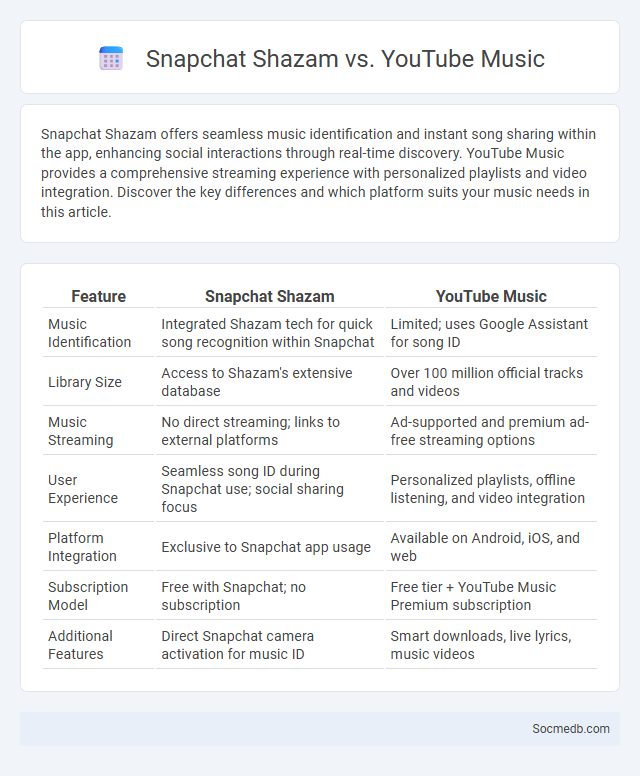
Photo illustration: Snapchat Shazam vs YouTube Music
Snapchat Shazam offers seamless music identification and instant song sharing within the app, enhancing social interactions through real-time discovery. YouTube Music provides a comprehensive streaming experience with personalized playlists and video integration. Discover the key differences and which platform suits your music needs in this article.
Table of Comparison
| Feature | Snapchat Shazam | YouTube Music |
|---|---|---|
| Music Identification | Integrated Shazam tech for quick song recognition within Snapchat | Limited; uses Google Assistant for song ID |
| Library Size | Access to Shazam's extensive database | Over 100 million official tracks and videos |
| Music Streaming | No direct streaming; links to external platforms | Ad-supported and premium ad-free streaming options |
| User Experience | Seamless song ID during Snapchat use; social sharing focus | Personalized playlists, offline listening, and video integration |
| Platform Integration | Exclusive to Snapchat app usage | Available on Android, iOS, and web |
| Subscription Model | Free with Snapchat; no subscription | Free tier + YouTube Music Premium subscription |
| Additional Features | Direct Snapchat camera activation for music ID | Smart downloads, live lyrics, music videos |
Introduction to Music Recognition in Apps
Music recognition technology in social media apps enables users to identify songs playing in their environment by analyzing audio samples in real-time using advanced algorithms and machine learning. Popular apps like Shazam and SoundHound have integrated this feature to enhance user engagement and provide seamless discovery of music within social platforms such as Instagram and TikTok. This innovation leverages vast music databases and acoustic fingerprinting to offer accurate identification, driving trends and interactive experiences in the digital music ecosystem.
Overview of Snapchat Shazam Integration
Snapchat's integration with Shazam allows users to seamlessly identify songs playing in their environment by simply pressing and holding the camera screen within the app. This feature enhances user engagement by providing instant access to song details, streaming links, and sharing options without leaving Snapchat. The collaboration leverages Shazam's extensive music recognition database, enriching the social media experience through real-time audio identification.
Key Features of YouTube Music’s Recognition Capabilities
YouTube Music leverages advanced machine learning algorithms to identify songs from diverse audio inputs, including humming, lyrics, and background noise. Its robust recognition capabilities enable accurate detection of tracks even in noisy environments or incomplete audio snippets. The platform continuously updates its extensive music database to improve matching precision and user experience.
Standalone Shazam App: Strengths and Limitations
The Standalone Shazam app excels in quickly identifying music tracks through audio recognition technology, enhancing Your social media content with accurate song tags and seamless integration for sharing discoveries. Its strength lies in its extensive music database and offline recognition capability, allowing users to identify songs even without internet access. However, limitations include occasional misidentifications of obscure tracks and dependency on microphone quality, which can affect recognition accuracy in noisy environments.
User Experience: Snapchat Shazam vs YouTube Music
Snapchat Shazam integrates music identification seamlessly within social media interactions, providing instant song recognition through camera-based scanning that enhances user engagement and discovery. YouTube Music offers a comprehensive music streaming platform with personalized playlists, offline listening, and video integration, catering to users seeking a full music experience beyond identification. Snapchat Shazam excels in quick, interactive music detection within a social context, while YouTube Music prioritizes in-depth music consumption and library management.
Music Discovery and Song Identification Accuracy
Social media platforms increasingly leverage advanced algorithms and AI to enhance music discovery, providing personalized recommendations based on Your listening habits and interactions. Features like song identification tools seamlessly recognize tracks from short audio clips, ensuring high accuracy that connects You with new artists and genres. These innovations transform social media into a dynamic hub for exploring and sharing diverse musical content.
Integration with Playlists and Music Libraries
Social media platforms increasingly integrate with playlists and music libraries to enhance user experience and engagement by allowing seamless sharing and discovery of music content. These integrations enable users to embed tracks directly into posts, stories, and profiles, linking to popular streaming services like Spotify, Apple Music, and YouTube Music for instant playback. Advanced algorithms leverage these connections to recommend personalized playlists, driving increased interaction and expanded reach across social networks.
Privacy and Data Handling Comparisons
Social media platforms vary significantly in their privacy policies and data handling practices, with some offering end-to-end encryption and minimal data retention while others collect extensive user information for targeted advertising. Facebook and Instagram, owned by Meta, are known for comprehensive data collection and sharing with third-party advertisers, whereas platforms like Signal prioritize user privacy by limiting data access and employing robust encryption. Understanding these differences helps users make informed decisions about which social media services align best with their privacy expectations and data security needs.
Cross-Platform Compatibility and Ecosystem Support
Social media platforms prioritize cross-platform compatibility to ensure seamless user experience across devices such as smartphones, tablets, and desktops, enhancing accessibility and engagement. Ecosystem support integrates with third-party apps, APIs, and services like Instagram's connection with Facebook Business Suite, streamlining content management and advertising campaigns. Robust cross-platform frameworks and extensive API availability drive unified social media strategies and analytics across diverse digital environments.
Which Music Recognition Tool is Right for You?
Choosing the right music recognition tool depends on your specific needs, such as real-time identification, lyric display, or playlist integration. Popular options include Shazam, known for its extensive database and fast identification, and SoundHound, which offers voice search and singing recognition features. Evaluate tools based on compatibility with your devices, accuracy in noisy environments, and social sharing capabilities to enhance your social media music experience.
 socmedb.com
socmedb.com